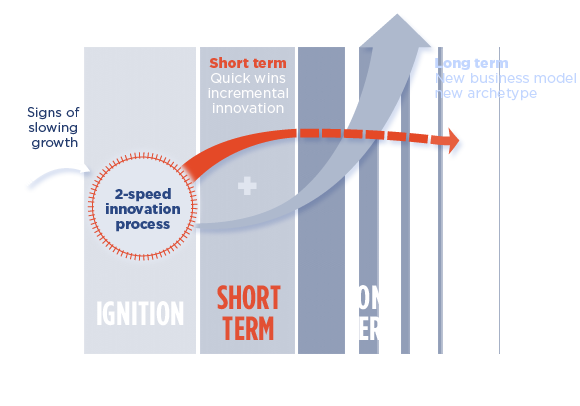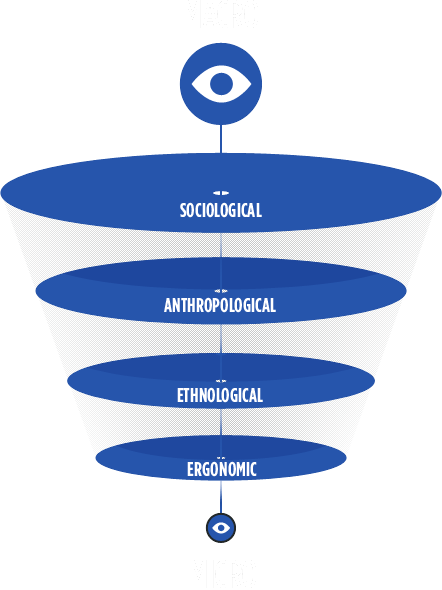Innovation Process
InProcess designs people-inspired innovations to energize your next model, business, product or service.
Business must be fuelled. Our human-centric scientific method paves the way for new approaches that create value for organizations and new business models for innovative companies.
We help you to build an innovation strategy today to accelerate your business tomorrow. Innovation is the best way to improve an existing model in the near term, while also making smart decisions to prepare for medium to long-term growth!
We encourage a two-speed approach to innovation.

Guarantee high impact
innovation with the I.R.I.S.™
innovation method

At InProcess we have designed the I.R.I.S.™ method (InProcess’ Research Ignites Solutions), a solid and patented scientific process to build effective innovation strategies. Why? Simply because we strongly believe in 2 facts :
Innovation is not intuition
Your future and your investments cannot be driven by chance.
Impactful innovation
is always fundamentally
human-driven
It all starts with your users and their needs for a better life. And it is led by the people within your team. They will need to be the best advocates of your innovation program.

What does our human-centered innovation
approach primarily bring you?
Our hybrid approach brings together the world of research and the world of design: their combination constitutes a solid methodological starting point for your innovation adventure. Our human-centered innovation method:
- accelerates growth and competitiveness,
- reduces financial, industrial & management risks,
- increases appropriation by end-users,
- mobilizes internal resources towards clarified goals,
- generates new knowledge,
- and builds up a broader innovation culture which positively influences
future innovation success.

Start your innovation
adventure today!
You will quickly detect and exploit future fruitful areas for growth, ensure these next models will positively engage your end-users and guarantee support from your internal stakeholders. You will discover that the innovation adventure is a beneficial process which:
- Builds human-centric models, products, services, experiences and businesses.
- Improves your existing models.
- Can create disruptive innovations.
- Breathes innovation into your organizations.
- Delivers innovation to the people you really want to engage with.
I.R.I.S.™ Our human-centered innovation process
InProcess’ Research Ignites Solutions: the I.R.I.S.™ method

1
We explore your users
at a macro scale
Because latent needs and behaviors forecast
emblematic trends.
Take a closer look!
2
We explore
their daily gestures
at a micro scale
Because
weak signals forecast
future behaviors.
Take a closer look!
4
We shape tangible scenarios
for an ideal experience
Because visual scenarios stimulate immediate
appropriation by end-users and internal teams.
Take a closer look!
5
We locate the epicentres
of these experiences
in our concept labs
Concept Labs are a key moment of truth: ideal life meets emblematic users’ real lives. They bring to light the crucial components of the future experience: the epicentres of the innovation.
Take a closer look!
6
We help make business decisions
for the short / medium / long term
We work together with you to build your next models of products, services and experiences to shape the future of your business.
Take a closer look!
8
We infuse change management
within complex organizations
Innovation culture and design thinking sustain your next models’ implementation and the engagement into future successful practice.
Ethnographic
observation
Our researchers prepare a fertile field for innovation through multi-focal observations.

A ‘micro’ level of observation fuels insights via a ‘bottom-up’ approach
. ergonomic fieldwork allows us to observe gestures, ease of use, obstacles, coping mechanisms.
. the ethnological approach helps us to learn about how products or services have evolved in key parts of our society.
A ‘macro’ level of observation fuels insights with a ‘top-down’ approach
. a sociological approach via the observation of social shifts taking place over long periods allows us to identify key elements that will drive major change
. anthropological fieldwork allows us to observe the objects used, methods of use, contexts, types of locations, temporal patterns, functional and symbolic roles, and uses at each life stages.
The key insights that we identify represent hidden sources of innovation.
All of them illustrate a major inspiration for the short and long-term. Now our research teams are ready to work together with our design teams to create innovation scenarios that will lead to your innovation solutions.
Scenario
& prototypes
The innovation scenario is the keystone that connects knowledge and creation
A scenario is a series of illustrations that tell the story of a specific life experience. It can be the experience of interacting with a product, a service, a space or a person. Our designers illustrate scenarios of experiences that enable you and us to broaden our understanding and explore new, rich, uncharted regions.

From scenarios of today’s experiences to scenarios of ideal experiences
Based on the insights from our ethnographic observations, our designers start with depicting the experiences and needs of end users in their day to day life.
Then they create scenarios of “projected experiences”, which are ideal stories about consumers who are enjoying new experiences with new interactions in new contexts. They may be simple, subtle or service driven. They can be poetic, disconcerting and are always inspiring.
At this stage, the output is not a product or service solution, but rather new experiences that are desirable for your future customers.
We test these stories with end-users in our Concept Labs
We measure their level of interest, according to their profile, for imagining themselves positively or negatively living with each experience. We work iteratively with them to help the scenario mature.
We then identify the ‘epicentres’ of the ideal experiences
They reveal the vital components of a new customer’s experience. The shopping bag is the epicentre of the shopping experience today. The touch screen is the epicentre of the experience of Apple's portable hardware offer. It may be an object, an interface, or a relationship with a service, a person or a space. It comes into being at the moment the experience is created. It may be continuous or discontinuous. Real or virtual. Useful or trivial (trivial can be important too!). It is the core of the experience.
It is highly strategic to give this epicentre a shape. So our designers bring it to life with a prototype so that it can be thoroughly shared with your internal teams and experienced by your end-users.
Our designers and engineers help drive your innovation project up to the industrial level. They handle the post design steps, can create the requirements documents and can also manage relationships with your manufacturer.
The innovation scenario is the most powerful tool to drive creativity,
iterate and prototype solutions, and lead quickly to an innovation
that will be easily adopted by organizations and end-users
• It gathers together all the insights stemming from the research phase and presents them in a narrative format setting out the ‘need states’ that must be addressed.
• It allows this material to be shared quickly and effectively within a project team so that all team members understand the end customer’s needs and what the challenges are.
• It allows us to develop a projective approach to working on the construction of an experience while stopping us from trying to come out with technical solutions too soon (which we know have very little chance of being relevant at this stage of the project).
• It may be used as part of a Concept Lab to re-work and enhance the idea iteratively with potential consumers and thus boost its relevance.
• Finally, it enables us to identify the ‘epicentres of ideal experiences’ that will allow us to build the offer of tomorrow.



























